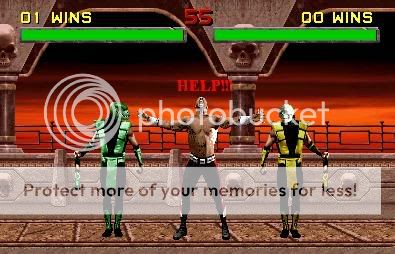Kabal has a hari kari in UMK3 for Sega Genesis
2D Kombat Klassics
Pages: 1
Kabal has a hari kari in UMK3 for Sega Genesis
0
posted05/31/2004 04:34 AM (UTC)by
I swear on my life that Kabal in UMK3 has a hari kari. I have never swear anything on my life but today I swearing that I found something new. Here the story, I got out my sega genesis to play some old game and there was UMK3, so I put it in and pick Kabal, while in the second round of the match I uppercut the opponent to end the match. While fooling around I hold on the HP button for 3 second and what came into my mind was foward, foward, down, foward, and I released the HP. All of a sudden Kabal head came off, I was amaze and I try it again and the same thing happen, Kabal finish himself. If you don't believe me then I will take a picture of myself doing the actual finish move but you got to tell me how to upload to the message board because I don't have a digital camera. And one more thing should I contact some at Midway about this.


0
I've never heard about it, please post the pic :)
About Me
TheProphet, GGs my friend. Give'em Hell.
0
I found this a while back and I think it came up on this board since then as well. I remembered Kabal's fatalities, but did the wrong one. I did his brutality instead of a fatality I believe it was and it caused his head to pop off. It can also cause a multicolored Kano to appear on screen and uppercut your opponent. Its pretty funny.


0
damn that's cool lol! I didn't know about that it's new to me


About Me
- Your Source for UMK3 Competition -
When something better than UMK3 comes out, I'll let you all know, because it still hasn't happened yet.
0
I posted this a long time ago in a glitches thread, DreemerNJ found it a few years ago, I think we found one website with it documented, it's funny, there's a related glitch in an early MK3 version, doing Kabal's animality resets the game.

Matt

Matt


About Me

0
By the way, I'm almost positive that it is pronounces "Hara Kiri" not "Hari Kari"
It's spelled Hara Kiri.
The Columbia Encyclopedia, Sixth Edition. 2001.
hara-kiri
(här ́-kr ́, hr ́) (KEY) [Jap.,=belly-cutting], the traditional Japanese form of honorable suicide, also known by its Chinese equivalent, seppuku. It was practiced by the Japanese feudal warrior class in order to avoid falling into enemy hands. Around 1500, it became a privileged alternative to execution, granted to daimyo and samurai guilty of disloyalty to the emperor. The condemned man received a jeweled dagger from the emperor. He selected as his second a faithful friend, received official witnesses, and plunged the dagger into the left side of his abdomen, drew it across to the right, and made a slight cut upward; his second then beheaded him with one stroke of a sword, and the dagger was returned to the emperor. Around 1700, it became permissible to go through a semblance of disembowelment prior to beheading. Voluntary hara-kiri was resorted to after a private misfortune, out of loyalty to a dead master, or to protest the conduct of a living superior. 1
Obligatory hara-kiri was abolished in 1868, but its voluntary form has persisted. It was performed by 40 military men in 1895 as a protest against the return of conquered territory, the Liaotung peninsula, to China; by General Nogi on the death of Emperor Meiji in 1912; and by numerous soldiers as an alternative to surrender in World War II. Hara-kiri was much discussed in recent years in connection with the death, in 1970, of Mishima, the well-known novelist and rightist political leader. 2
See bushido, kamikaze, suicide. 3
For detailed accounts of hara-kiri, see A. B. F. Redesdale, Tales of Old Japan (1919).
The Columbia Encyclopedia, Sixth Edition. 2001.
hara-kiri
(här ́-kr ́, hr ́) (KEY) [Jap.,=belly-cutting], the traditional Japanese form of honorable suicide, also known by its Chinese equivalent, seppuku. It was practiced by the Japanese feudal warrior class in order to avoid falling into enemy hands. Around 1500, it became a privileged alternative to execution, granted to daimyo and samurai guilty of disloyalty to the emperor. The condemned man received a jeweled dagger from the emperor. He selected as his second a faithful friend, received official witnesses, and plunged the dagger into the left side of his abdomen, drew it across to the right, and made a slight cut upward; his second then beheaded him with one stroke of a sword, and the dagger was returned to the emperor. Around 1700, it became permissible to go through a semblance of disembowelment prior to beheading. Voluntary hara-kiri was resorted to after a private misfortune, out of loyalty to a dead master, or to protest the conduct of a living superior. 1
Obligatory hara-kiri was abolished in 1868, but its voluntary form has persisted. It was performed by 40 military men in 1895 as a protest against the return of conquered territory, the Liaotung peninsula, to China; by General Nogi on the death of Emperor Meiji in 1912; and by numerous soldiers as an alternative to surrender in World War II. Hara-kiri was much discussed in recent years in connection with the death, in 1970, of Mishima, the well-known novelist and rightist political leader. 2
See bushido, kamikaze, suicide. 3
For detailed accounts of hara-kiri, see A. B. F. Redesdale, Tales of Old Japan (1919).
Pages: 1
© 1998-2025 Shadow Knight Media, LLC. All rights reserved. Mortal Kombat, the dragon logo and all character names are trademarks and copyright of Warner Bros. Entertainment Inc.










